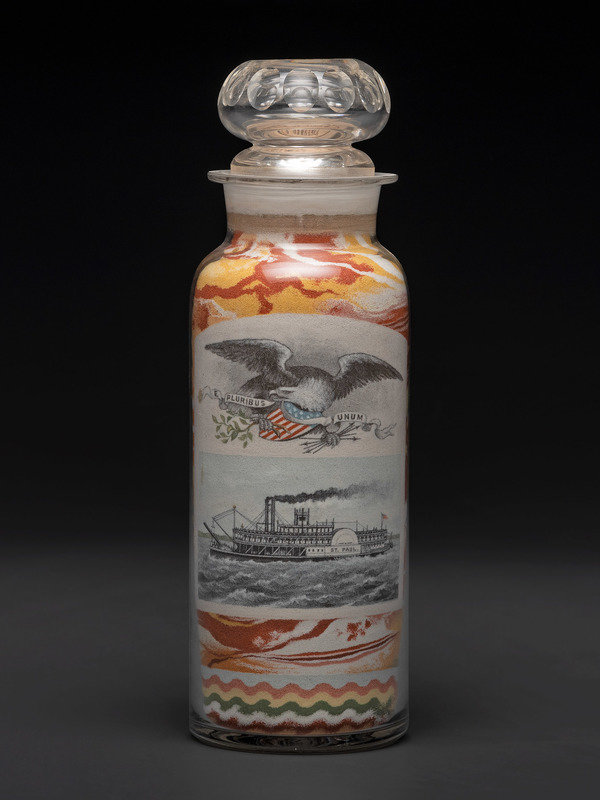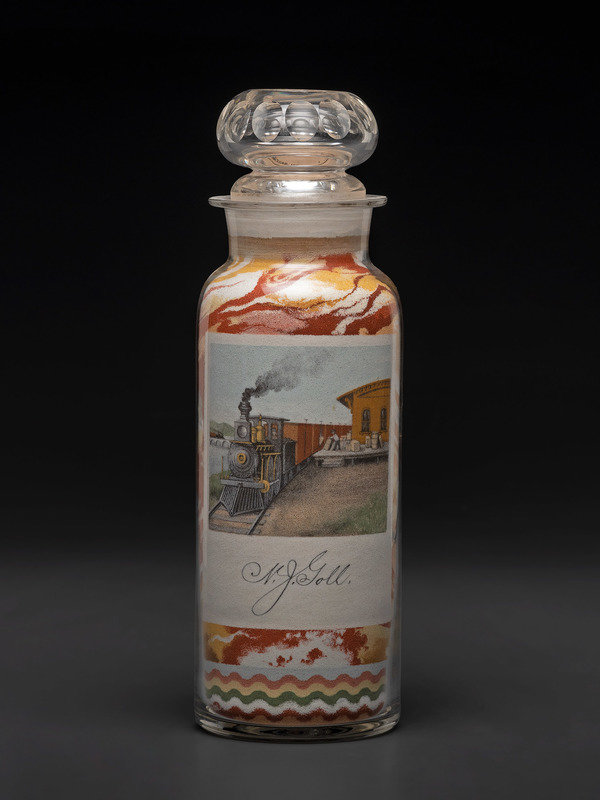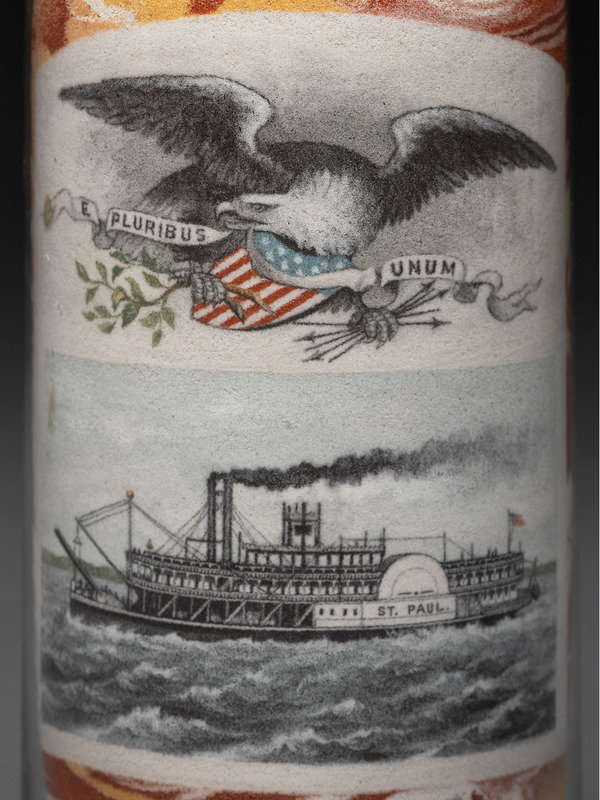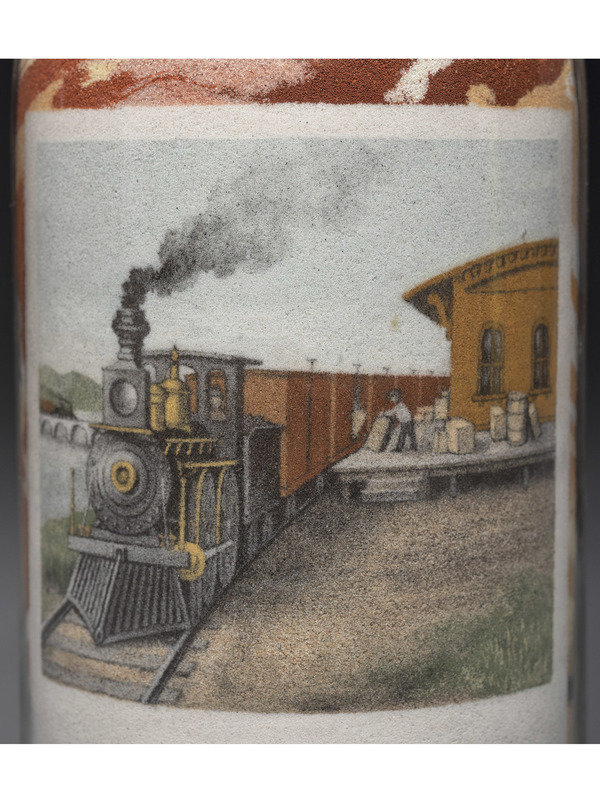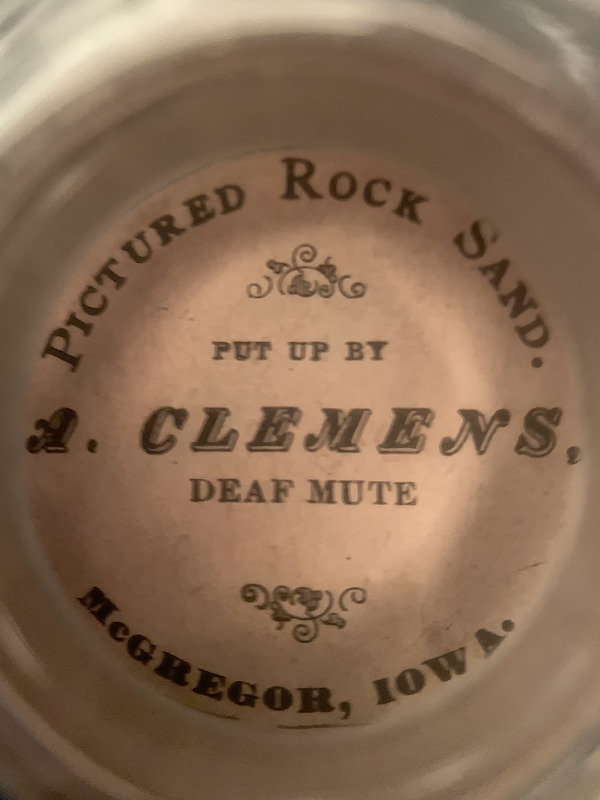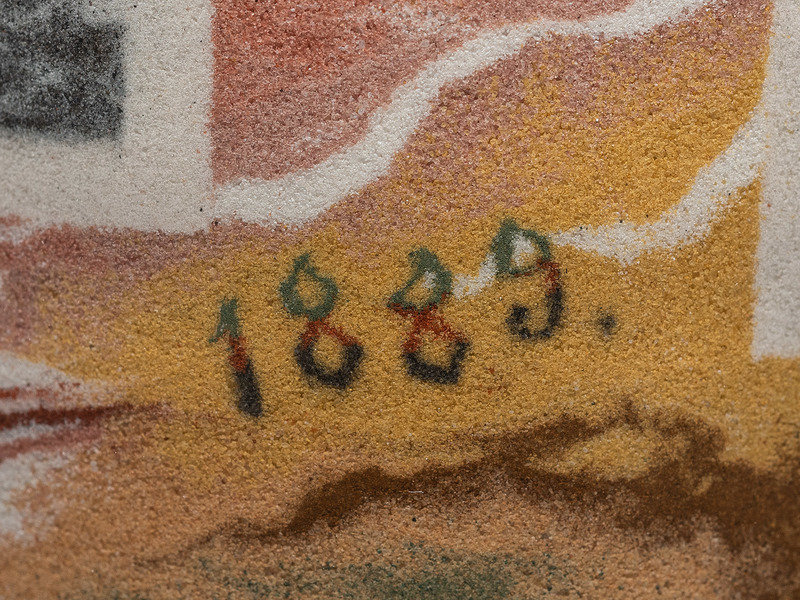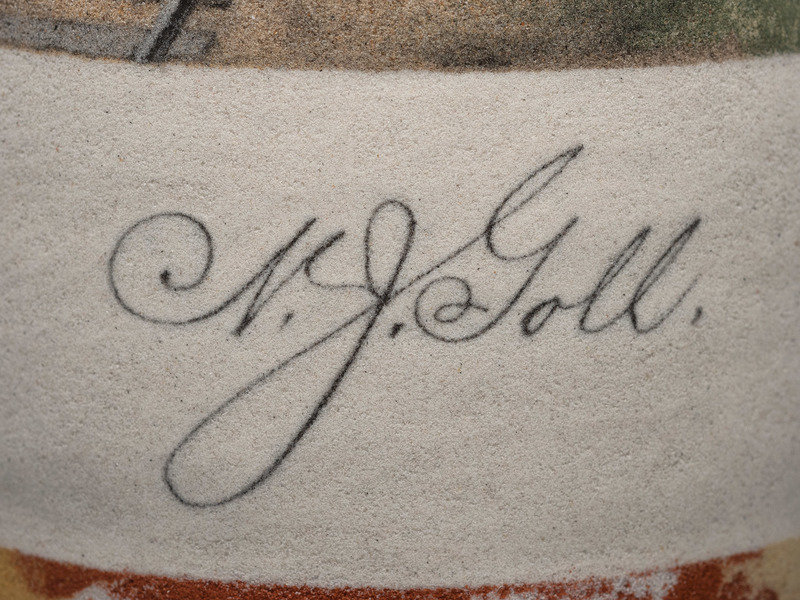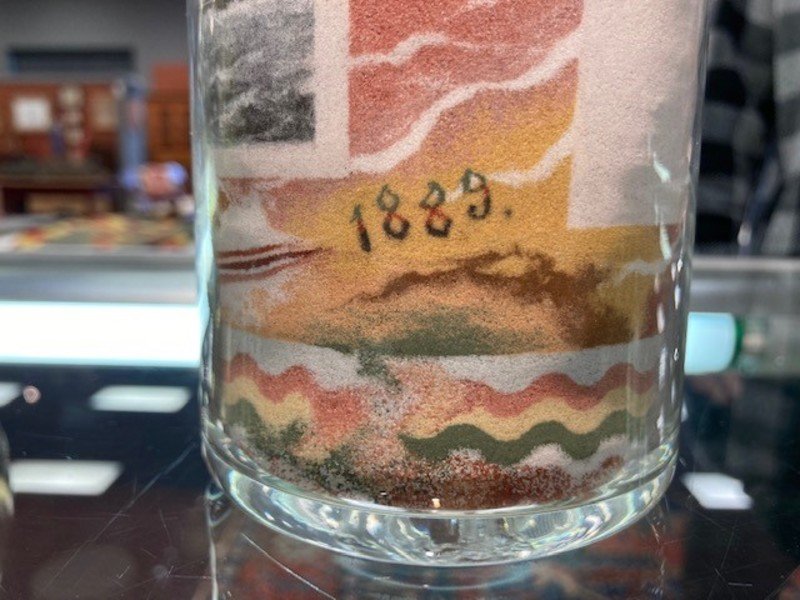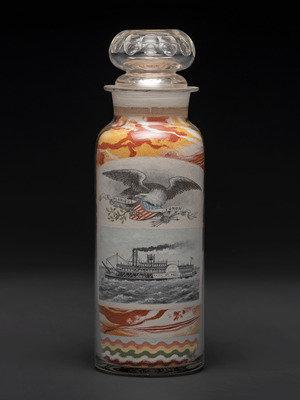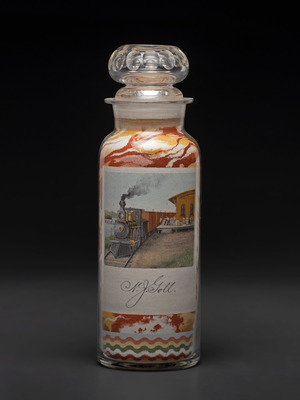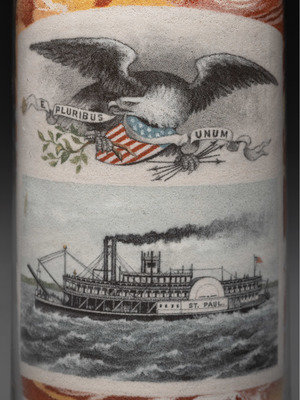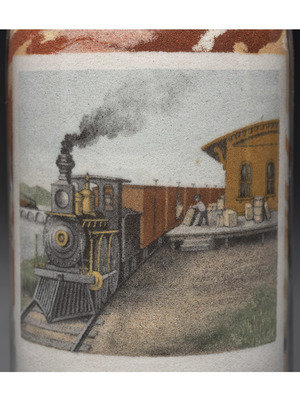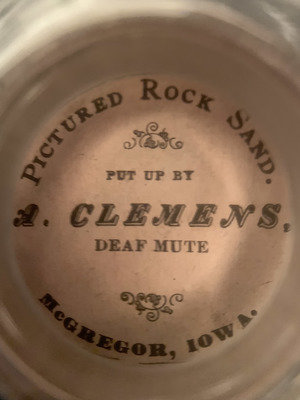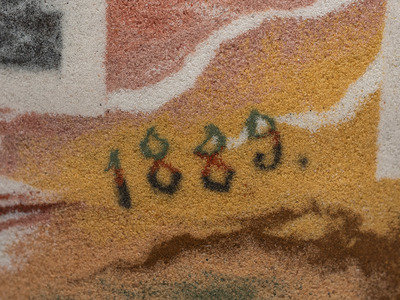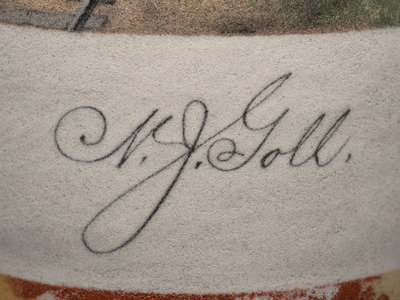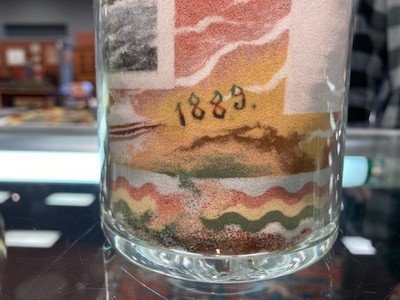Condition Report
Contact Information
Auction Specialist
Lot 297
An Impressive Masterwork Andrew Clemens (American, 1857-1894) Labeled Sand Bottle
Sale 993 - American Furniture, Folk & Decorative Arts
Lots 1-335
Mar 10, 2022
5:00AM ET
Lots 336-681
Mar 11, 2022
5:00AM ET
Live / Cincinnati
Own a similar item?
Estimate
$100,000 -
150,000
Price Realized
$800,000
Sold prices are inclusive of Buyer’s Premium
Lot Description
An Impressive Masterwork Andrew Clemens (American, 1857-1894) Labeled Sand Bottle
Made for Railroad Freight Agent Nicholas J. Goll (1840-1903), Dated 1889
visible through the top of the stopper of the bottle is a black and white printed paper label reading Pictured Rock Sand, Put Up By Andrew Clemens, Deaf-Mute, McGregor, Iowa.
Height with stopper 10 1/2 inches.
Height without stopper 8 3/4 inches.
Diameter 3 1/2 inches.
One side depicts a coal burning locomotive stopped at a railroad station, with freight cars stretching into the distance. A single figure is seen handling a large piece of freight, with others stacked on the siding in front of a train station. In the distance to the left, another locomotive can be seen pulling cars over a railroad bridge crossing a river. The decoration is polychrome, with shades of brown, black and gold predominate. The entire scene is set in a sharply delineated frame of sand set off against a white background.
Height with stopper 10 1/2 inches.
Height without stopper 8 3/4 inches.
Diameter 3 1/2 inches.
One side depicts a coal burning locomotive stopped at a railroad station, with freight cars stretching into the distance. A single figure is seen handling a large piece of freight, with others stacked on the siding in front of a train station. In the distance to the left, another locomotive can be seen pulling cars over a railroad bridge crossing a river. The decoration is polychrome, with shades of brown, black and gold predominate. The entire scene is set in a sharply delineated frame of sand set off against a white background.
Below this scene, written in script, is the name N. J. Goll.
The other side of the bottle is divided into two decorative panels. The top features a spread-winged eagle clutching arrows and green olive branches in its talons, and a patriotic shield and ribbon banner proclaiming E. Pluribus Unum. Below a sidewheel packet boat under a full head of steam is depicted with the name St. Paul in block lettering on the paddle box. The steamboat is set off from the rest of the bottle by a sharply delineated frame of sand grains. The decoration on this side of the bottle is en grissaile save for red details in the patriotic shield, an American flag at the stern of the packet boat, and a blue sky in the background of the river scene.
The main panels are contrasted with varying swirling and uniform devices of colored sand, and near the bottom of the bottle, the date 1889.
Nicholas J. Goll was born in St. Louis, Missouri and spent most of his life in that town. At an early age, he embarked on a life-long career working for the railroad. Beginning in November 1861, his first job was as a way-bill clerk with the Indianapolis and St. Louis Railroad. From this point forward, he held successive positions with various railroads, ending his career as Assistant General Freight Agent, Chicago Milwaukee & St. Paul Railway, a position he held for nine years until his death (1894-1903). Though most of his career seems to have been in St. Louis, at the time of his death he was living in Chicago, the home office of the Chicago, Milwaukee, and St. Paul (Busby, editor, 1893:143; Cook County, Illinois Death Records).
Goll’s work history is reflected in the bottle, and the routes of the Chicago Milwaukee & St. Paul Railway are key to understanding its history. At the time the bottle was made, one of the major trunks of the railroad ran from Milwaukee, Wisconsin to Rapid City, South Dakota through McGregor, Iowa, crossing the Mississippi River just upstream at Prairie Du Chien, Wisconsin. McGregor was a major transshipment point for midwestern wheat and was also a regular stop for steamboat traffic.
The Goll Bottle Within Clemen’s Existing Body of Work
At a height of 10 1/2 inches and a diameter of 3 1/2 inches, the Goll bottle is unusually large for Clemens’ body of work. The faceted stopper and the location of his printed label inside the bottle is also atypical.
Clemens routinely used an American eagle and flag in his bottles. In the more than 100 bottles known to exist, this is one of only two known to incorporate an eagle and patriotic shield.
Dated 1889, five years before Clemens’ death, the Goll bottle amply demonstrates Clemens’ mastery of his life’s work. Like most of his bottles, it was undoubtedly commissioned for its new owner. In this case, whether Goll ordered the bottle is not important. The bottle incorporates motifs that would have been important to his career: the railroad and packet industries.
Trains were occasionally utilized in Clemens’ bottles, and he is known to have made more than one for railroad owners or executives (Sucholeiki 2015: 26-30). One of these bottles (now lost) weighed 20 pounds and depicted a train crossing a pontoon bridge over the Mississippi at McGregor. His most common railroad bottle incorporates a simple profile depiction of a locomotive pulling a coal tender and belching smoke.
The Goll bottle departs from this convention by depicting a locomotive at work. In this case, the locomotive and attendant box cars are pulled up to a train station and loading dock with a worker wrestling a hogshead towards an open boxcar door. Crates and other boxes are piled on the dock, and in the distance another train crosses the well-known James J. Hill Stone Arch Bridge spanning the Mississippi at St. Paul, Minnesota.
While the inspiration for his locomotive is unknown, his steamboat decoration is clearly copied from advertisements of the Diamond Jo Steamboat Line. The owner of the line, Joseph “Diamond Joe’ Reynolds (1819-1891), moved to McGregor in 1860 to take advantage of the burgeoning grain production and established a steamboat line to transport grain to the railhead at Prairie du Chien, Wisconsin. Dubbed the Diamond Jo Line, Reynolds’ company eventually grew to incorporate several steamers plying the upper and lower Mississippi.
Built in 1883, the St. Paul was part of the Diamond Jo Line running the St. Paul-St. Louis route and was undoubtedly a frequent visitor at the McGregor wharf (Way, 1883:414). Her depiction on the Goll bottle is a reminder of the position of McGregor’s place in regional commerce, and more than likely, Goll’s business. The same steamboat is found on several Clemens bottles, including the Grey Eagle, another Diamond Jo property.
History of the Bottle
Nicholas J. Goll (1840-1903) married Minerva Gordon (1841 -1904). They had one son, Walter J. Goll (1872-1943), who never married and at the time of his death was living in Fort Wayne, Indiana.
According to family history, Minerva’s sister Elizabeth Gordon Voorhis died young, and Nicholas and Minerva helped raise her two daughters, one of whom, Maggie Dryden Voorhis was the consignor’s great-great-grandmother. Walter Goll never married and had no children but was close to Maggie and her daughter Margaret DePrez of Shelbyville, Indiana. At Walter’s death, his estate -- and presumably the bottle – was apparently left to Margaret DePrez. It is through this line that the bottle passed to the present owners.
Probable Line of Descent
Nicholas Goll (1840-1903)
Minerva Goll(1841-1904)
Walter Goll (1872-1943)
Margaret DePrez (1870-1949)
To the family of the current owner
References Cited
Busby, T. A., Editor. 1893, The Biographical Directory of the Railway Officials of America. Published by the Railway Age and Northwestern Railroad. The Lakeside Press. Chicago.
Way Jr., Frederick. 1983, Way’s Packet Directory, 1848-1983. Passenger Steamboats of the Mississippi River System since the advent of photography in Mid-Continent America. Ohio University Press.
